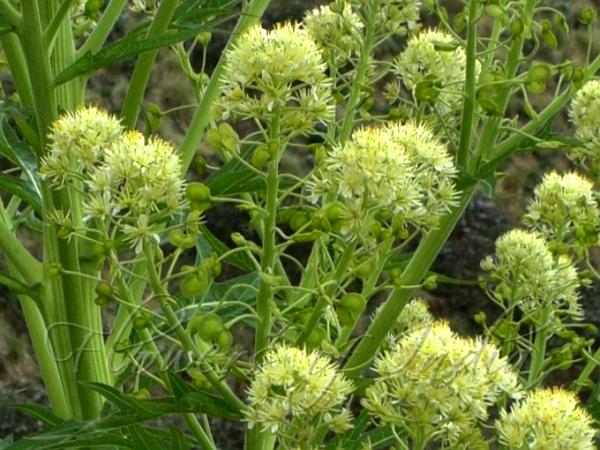|
| Barmola |
|

|

| File size | 175134 |
| Original date | 6/13/19 1:54 PM |
| Resolution | 3681 x 2833 |
| Flash | Flash did not fire |
| Focal length | 18.0mm |
| Exposure time | 1/160s |
| Aperture | 13.0 |
| Focus Distance | |
| Metering Mode | Center weighted average |
| Camera make | NIKON CORPORATION |
| Camera model | NIKON D5300 |
| Sensor type | OneChipColorArea |
|
|
|
|
Photo: |
Botanical name: Megacarpaea polyandra Family: Brassicaceae (Mustard family)
Barmola is a perennial (quite likely endangered) herb, native to
western Himalaya. It is one of the giant alpine herbs, growing up to 2 m
tall. Stem is hollow, erect much branching. Leaves are cut in a double
compounded form, basal leaves having long stalks, stem leaves
short leaf-stalked or stalkless. Flowers are borne in profusely
flowered racemes. Flowers are pale yellow, sepals yellowish, oblong,
3.5-5 x 1.5-2.5 mm, sparsely velvet-hairy or hairless. Petals are pale
yellow, oblong or obovate, entire, 4-6 x 2-4 mm, base wedge-shaped,
tip rounded to somewhat pointed. Stamens re 8-12, more than the usual
six stamens, a feature that distinguishes it from the other species
of the mustard family. Flower-stalks are not slender, but are thread-like
in fruit. Fruit is large, nearly-round, disclike 3-3.5 cm
long, 3.5-5 cm broad, bilobed, deeply notched at the tip and slightly
at the base; wing about as broad as the locule; seed about 1 cm in
diameter, nearly round, not winged or margined, brown. Barmola is found
growing on slopes, rock crevices in alpine and subalpine zone of West and
Central Himalaya to Tibet, at altitudes of 3000-4000 m.
Flowering-May-July.
Medicinal uses: Roots are used as medicine
against fever, a febrifuge and tonic. Decoctions of the root are used
to cure stomach pain and dysentery. Locally, dry leaves are fried with
ghee for the treatment of dysentery.
Roots are used as medicine
against fever, a febrifuge and tonic. Decoctions of the root are used
to cure stomach pain and dysentery. Locally, dry leaves are fried with
ghee for the treatment of dysentery.
Medicinal uses:
 Roots are used as medicine
against fever, a febrifuge and tonic. Decoctions of the root are used
to cure stomach pain and dysentery. Locally, dry leaves are fried with
ghee for the treatment of dysentery.
Roots are used as medicine
against fever, a febrifuge and tonic. Decoctions of the root are used
to cure stomach pain and dysentery. Locally, dry leaves are fried with
ghee for the treatment of dysentery. | Identification credit: Ankit Singh | Photographed in Tungnath, Rudraprayag, Uttarakhand. |
• Is this flower misidentified? If yes,